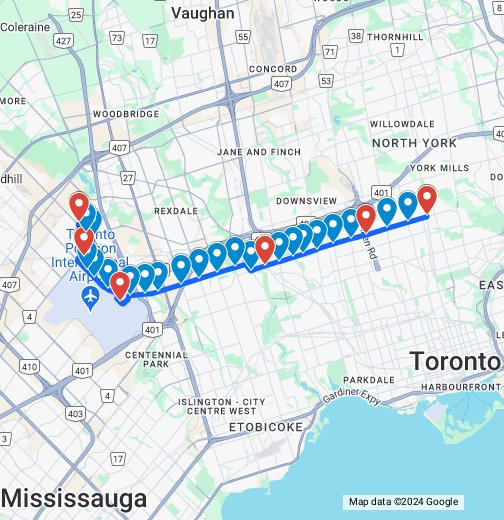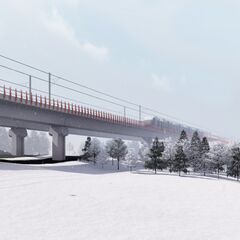|
|
| |||||||||||||||||||||
| |||||||||||||||||||||||
Toronto Eglinton Line 5 Crosstown West Extension | ?m | ?s | Metrolinx
- Thread starter W. K. Lis
- Start date
Rainforest
Senior Member
This relates to the crosstown in some way, but i made a map of what a Lawrence west rt line would look like. This could help relieve congestion if the eglinton west line ever gets congested

The sections between Jane / Lawrence and Dixon road, and between Bathurst and Yonge, will be challenging (limited space).
LeanMeanMemeMachine
New Member
Another example of some fairly nice stations (albeit not as grand as the ones in the pictures you posted), are the ones on Copenhagen's new M3 line, for example, the one below.You can bet none of these stations will be duplicated on any of the Eglinton West LRT stations.
From link.












Or, if you prefer, there's some better examples in the article in this link.
The reason I bring this up is because this style of station wouldn't be very ambitious to use when it comes to projects here in Toronto, since they're simple and inexpensive to build (read the paragraph about the "kit of parts" in the article), and still look really nice. I would love to see Metrolinx use something like this in various subway/LRT projects in Toronto (albeit with longer platforms, since Copenhagen's are quite short), and I find a system like this particularly likely to be used on the Ontario Line, although knowing Metrolinx, this may just be wishful thinking.
W. K. Lis
Superstar
Another example of some fairly nice stations (albeit not as grand as the ones in the pictures you posted), are the ones on Copenhagen's new M3 line, for example, the one below.
View attachment 250711
Or, if you prefer, there's some better examples in the article in this link.
The reason I bring this up is because this style of station wouldn't be very ambitious to use when it comes to projects here in Toronto, since they're simple and inexpensive to build (read the paragraph about the "kit of parts" in the article), and still look really nice. I would love to see Metrolinx use something like this in various subway/LRT projects in Toronto (albeit with longer platforms, since Copenhagen's are quite short), and I find a system like this particularly likely to be used on the Ontario Line, although knowing Metrolinx, this may just be wishful thinking.
Again, the fiscal conservatives will rather save money than save lives using platform doors.
LeanMeanMemeMachine
New Member
A real shame, especially since inevitable plans to install platform doors along the TTC system (it's only a matter of time until proposals pop up to retrofit many of the existing stations with them) will cost more because of the shortsightedness and money-saving intentions of the people planning these projects. A large part of the reason I thought a solution like the one used on Copenhagen's M3 (and their entire system, since afaik all of their stations have platform doors) was more likely on the Ontario Line because Metrolinx is already planning to put platform doors in at all of the stations on the Ontario Line, but there's plenty of time for them to revert on that decision too, although, luckily, I don't see them removing plans for platform doors. There would be too much public backlash, which, frankly, I think was a large part of the reason why Metrolinx decided to bury the Eglinton Crosstown West extension.Again, the fiscal conservatives will rather save money than save lives using platform doors.
Steve X
Senior Member
If they plan to not install platform screen doors, they would have to install a system to prevent trains from killing jumpers. This happens a lot more often here than Vancouver and with a fully automatic system, plenty of people are going to attempt. Friday night is already a headache on the subway. Idiots decide that they would run in the tunnels cause trains aren't coming frequent enough.A real shame, especially since inevitable plans to install platform doors along the TTC system (it's only a matter of time until proposals pop up to retrofit many of the existing stations with them) will cost more because of the shortsightedness and money-saving intentions of the people planning these projects. A large part of the reason I thought a solution like the one used on Copenhagen's M3 (and their entire system, since afaik all of their stations have platform doors) was more likely on the Ontario Line because Metrolinx is already planning to put platform doors in at all of the stations on the Ontario Line, but there's plenty of time for them to revert on that decision too, although, luckily, I don't see them removing plans for platform doors. There would be too much public backlash, which, frankly, I think was a large part of the reason why Metrolinx decided to bury the Eglinton Crosstown West extension.
TheTigerMaster
Superstar
intoronto1125
Active Member
Anyone know when the amount of stops were reduced?
Amare
Senior Member
As soon as the province back took control of the project from the city, and decided to tunnel the entire western portion.Anyone know when the amount of stops were reduced?
Coolstar
Senior Member
The western portion isn't entirely tunnelled. Remember it's elevated from east of Jane to west of Scarlett in order to cross the Humber River.As soon as the province back took control of the project from the city, and decided to tunnel the entire western portion.
Amare
Senior Member
^That's correct indeed.
W. K. Lis
Superstar
TheTigerMaster
Superstar
Heres the thing you might not understand: even an LRT thats separated from traffic but in the center lane, with 0 intersections will operate slower than a fully separated line thats in a trench, at grade but fenced in, elevated, etc.
This is because there are mandatory speed limits for transit vehicles that operate on street, even if in their own dedicated lane, and pedestrians have the ability to interact with, even if its only at the stations. If theres no physical barrier separating the train from the possibility of someone on the tracks so the city standard for such transit system requires much slower speeds. As well, PTC or ATC cant be used, meaning slower speeds as well.
The difference is something like 50km/h (sometimes 40) vs 80-100kmh for separated
In theory you're correct, but in practice, I wouldn't expect to see trains running at 80 km/h+ at any point in the network. If my memory serves me correctly, the fastest point on the subway network is on Yonge southbound between Sheppard and Eglinton, and in that segment the trains never operate faster than 60 km/h, even though the equipment is technically capable of faster operations.
In terms of stop spacing and geography (and change in elevation is relevant), the Eglinton Line is more comparable to Line 2, which operates at between 30 and 40 km/h between stations in ideal conditions, but might even be substantially slower than that in some segments during peak usage. That's actually slower than the 40 km/h speed limit on the streets above.
I'd expect nearly all of the time savings with underground operation to be associated with the lack of stoplights, rather than the vehicles having a faster top speed.
Last edited:
Steve X
Senior Member
The more interesting thing is that the LRT is planned for 60-80 km/h operation at some points. In the noise modelling (Appendix D), we can see that Martin Grove to the portal east of Royal York is planned for 80 km/h while Renforth to Martin Grove and the elevated section from the portal to Mt Dennis is planned for 60 km/h.In theory you're correct, but in practice, I wouldn't expect to see trains running at 80 km/h+ at any point in the network. If my memory serves me correctly, the fastest point on the subway network is on Yonge southbound between Sheppard and Eglinton, and in that segment the trains never operate faster than 60 km/h, even though the equipment is technically capable of faster operations.
In terms of stop spacing and geography (and change in elevation is relevant), the Eglinton Line is more comparable to Line 2, which operates at between 30 and 40 km/h between stations in ideal conditions, but might even be substantially slower than that in some segments during peak usage. That's actually slower than the 40 km/h speed limit on the streets above.
I'd expect nearly all of the time savings with underground operation to be associated with the lack of stoplights, rather than the vehicles having a faster top speed.
It's also interested to note 3 special tracks are indicated at 3 stations, presumably a crossover at Martin Grove, storage track at Kipling and another crossover at Royal York.
sixrings
Senior Member
Also the pro underground model doesn't consider the time it takes to transfer from these deep station designs. Walking out at surface level takes seconds. Traveling up multiple elevators if they are even working will take several minutes.In theory you're correct, but in practice, I wouldn't expect to see trains running at 80 km/h+ at any point in the network. If my memory serves me correctly, the fastest point on the subway network is on Yonge southbound between Sheppard and Eglinton, and in that segment the trains never operate faster than 60 km/h, even though the equipment is technically capable of faster operations.
In terms of stop spacing and geography (and change in elevation is relevant), the Eglinton Line is more comparable to Line 2, which operates at between 30 and 40 km/h between stations in ideal conditions, but might even be substantially slower than that in some segments during peak usage. That's actually slower than the 40 km/h speed limit on the streets above.
I'd expect nearly all of the time savings with underground operation to be associated with the lack of stoplights, rather than the vehicles having a faster top speed.







